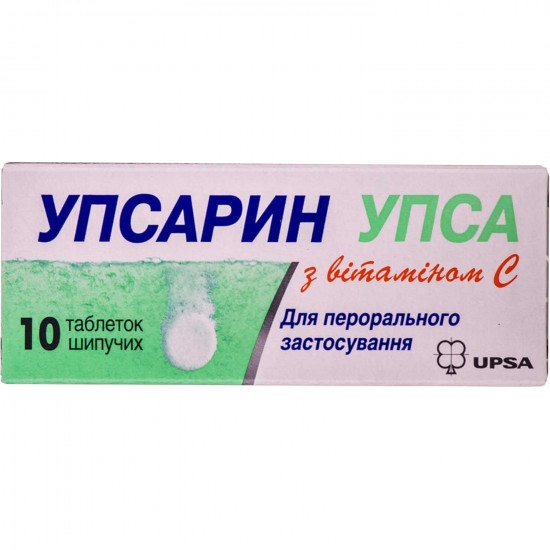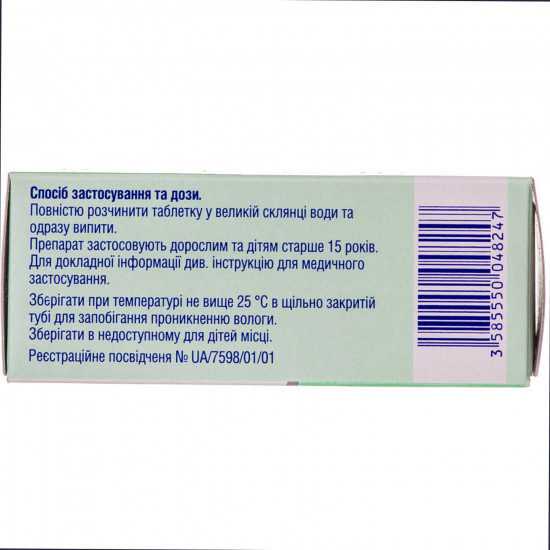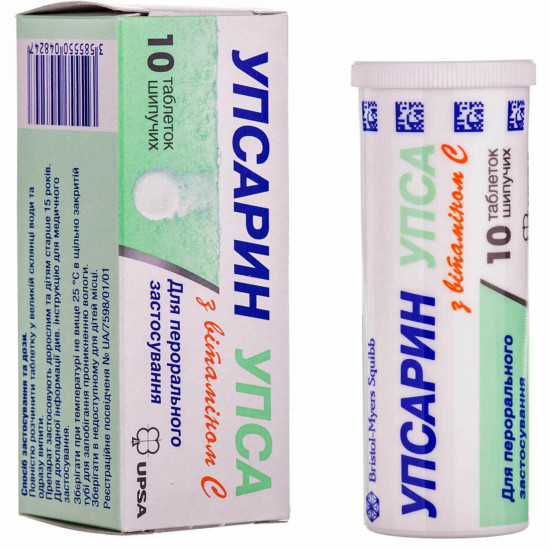





- Stock: In Stock
- Model: 182012
0% Customers recommend this product
-
5 Awesome0%
-
4 Great0%
-
3 Average0%
-
2 Bad0%
-
1 Poor0%
Reviews Over Upsarin Upsa about Vit. With the tab. a thorn. No. 10
- (0)
Total Reviews (0)
click here write review to add review for this product.
Report this review.
Description
Tablets sparkling "Upsarin Upsa with vitamin C" are applied to symptomatic treatment of a pain syndrome of weak and average intensity and/or fever.
Structure
One tablet sparkling contains (active ingredients):
- acetylsalicylic acid - 330 mg;
- ascorbic acid (vitamin C) - 200 mg.
Excipients: Natrii hydrocarbonas, citric acid anhydrous, povidone, Natrium benzoicum (E 211).
Contraindication
- hypersensitivity to acetylsalicylic acid, other salicylates, ascorbic acid or to any component of drug;
- bronchial asthma caused by intake of salicylates or other NPVS in the anamnesis;
- gastrointestinal ulcers;
- hemorrhagic diathesis;
- risk of bleeding;
- serious illness of kidneys, profound renal failure;
- urolithiasis;
- profound liver failure;
- profound heart failure;
- tendency to thromboses, thrombophlebitis;
- diabetes; combination with a methotrexate in a dose of 20 mg/week or is more than
- ;
- III a pregnancy trimester in a dose more than 100 mg a day;
- a combination of oral anticoagulants with anti-inflammatory doses (≥ 1 g on reception and/or ≥ 3 g a day) or the anesthetizing or febrifugal doses (≥ 500 mg on reception and/or <3 a day) acetylsalicylic acid.
Route of administration
For oral administration.
Completely to dissolve a tablet in a big glass of water and at once to drink.
Drug is used to adults and children is more senior than 15 years.
Adults and children with body weight more than 50 kg (about 15 years are also more senior): the maximum recommended daily dose makes 3 g of acetylsalicylic acid, that is 9 sparkling tablets a day.
Single dose makes two sparkling tablets. In case of need reception of a dose can be repeated in 4 hours.
Frequency of receptions
Regular receptions allow to avoid fluctuations of degree of pain and fever:
- aged from 15 years should observe a regular interval between receptions both in the afternoon, and at night, 6 hours, but are desirable not less than 4 hours;
- at adults the interval between receptions has to make not less than 4 hours.
Duration of treatment is defined by the doctor individually. It is necessary to remember that it is necessary to accept acetylsalicylic acid no more than 3 days for treatment of fever and no more than 5 days for treatment of pain.
Feature of use
Pregnant
can use Drug during pregnancy only in case other medicines are not effective. Salicylates can be applied during pregnancy only after ratio assessment risk/advantage.
As acetylsalicylic acid gets into breast milk, use of medicine during feeding is not recommended by a breast.
Children
children can use Drug aged from 15 years. It is not necessary to use the medicaments containing acetylsalicylic acid, to children with the acute respiratory viral infection (ARVI) which is followed or is not followed by fervescence. In some viral diseases, especially in flu A, flu B and chicken pox there is a risk of development of a syndrome of Ray which is very rare, but life-threatening disease, demands urgent medical intervention. The risk can be raised if acetylsalicylic acid is applied as the accompanying medicine, however relationship of cause and effect in this case is not proved. If the specified states are followed by long vomiting, it can be sign of a syndrome of Ray.
byDrivers
did not note influence on ability to drive the car or work with other mechanisms.
OverdoseOverdose of salicylates is possible
because of the chronic intoxication which arose owing to long therapy (use more than 100 mg/kg/days can cause more than 2 days toxic effects) and also because of acute intoxication, life-threatening (overdose) and which reasons can be, for example, an accidental use by children or unexpected overdose.
Chronic poisoning with salicylates can have the hidden character as its signs nonspecific. The moderate chronic intoxication caused by salicylates or a salitsilizm, meets usually only after reception of high doses.
Symptoms
Moderate intoxication can be followed by increase in respiration rate, a hyperventilation, the respiratory alkalosis, alkali reaction of urine strengthened by sweating, nausea, vomiting. Intoxication of heavy and average degree is followed by a respiratory alkalosis with development of a compensatory metabolic acidosis, an acidemia, an aciduria, a hyper pyrexia; from a respiratory system: from a hyperventilation, not cardiogenic fluid lungs to an apnoea and asphyxia; from a cardiovascular system: from disturbance of a warm rhythm and arterial hypotension to cardiac arrest; dehydration, oliguria, renal failure, disturbances of metabolism of glucose, ketosis, gastrointestinal bleedings; hematologic changes from oppression of aggregation of thrombocytes to a coagulopathy; from nervous system: toxic encephalopathy and oppression of central nervous system, can be shown in the form of slackness, oppression of consciousness, a coma and epileptic seizures.
Overdose by ascorbic acid can leadto oxidizing hemolysis at patients with deficit glyukozo-6-fosfatdegidrogenazy, at DVS and also at the increased level of oxalates in blood serum and urine. It was revealed that the increased level of oxalates leads to adjournment of calcium at the patients who are on dialysis. Also symptoms are balance disturbance, dizziness, a ring in ears, deafness, a headache, confusion of consciousness. The specified symptoms can be controlled a dose decline. The ring in ears can be noted at concentration of salicylates in blood plasma more than 150-300 mkg/ml. Serious side reactions meet at concentration of salicylates in blood plasma more than 300 mkg/ml.
significant change of acid-base balance which can differ depending on age and weight of intoxication testifies To acute intoxication. The most general indicator for children is the metabolic acidosis. Weight of a state cannot be estimated only on the basis of concentration of salicylates in blood plasma. Absorption of acetylsalicylic acid can slow down in connection with a delay of gastric release, forming of concrements in a stomach or at administration of medicament in the form of the tablets covered with an enterosoluble cover.
Treatment
Treatment of intoxication caused by overdose by acetylsalicylic acid is defined by severity, clinical symptoms and is provided with standard methods which apply in poisoning. All taken measures have to be directed to acceleration of removal of medicament and recovery of electrolytic and acid-base balance. To apply activated carbon, the forced alkaline diuresis. Depending on a condition of acid-base equilibrium and electrolytic balance to carry out infusional administration of solutions of electrolytes. In serious poisonings the hemodialysis is shown.
Side effects
Gastrointestinal disorders: dyspepsia, pain in epigastric area and an abdominal pain, heartburn, diarrhea, nausea, vomiting, stomach spasms.
System of blood: the increased risk of developing bleedings; intraoperative hemorrhages, hematomas, bleedings from bodies of an urinogenital system, nasal bleedings, odontorrhagias, a purpura.
Allergic reactions: rash, urticaria, Quincke's edema, itching, rhinitis, congestion of a nose, eczema.
At patients with bronchial asthma the increase in frequency of emergence of a bronchospasm is possible; allergic reactions from insignificant to moderate degree which potentially affect skin, a respiratory system, digestive tract and a cardiovascular system.
Nervous system: a headache, vertigo, increased fatigue, feeling of decrease in hearing, dizziness and a ring in ears that can demonstrate overdose.
are possibleAt prolonged use in high doses: damages of the glomerular device of kidneys, formation of uratny and/or oxalic concrements to kidneys and urinary tract, renal failure; damages of the insulyarny device of a pancreas (hyperglycemia, a glucosuria) and disturbance of synthesis of a glycogen before appearance of diabetes, myocardium dystrophy; thrombocytosis, giperprotrombinemiya, erythrocytopenia, neutrophylic leukocytosis, hemolytic anemia; decrease in permeability of capillaries (deterioration in a trophicity of fabrics, increase in arterial blood pressure is possible); dysbacteriosis of an oral cavity; disturbance of exchange of zinc, copper. At patients with deficit glyukozo-6-fosfatdegidrogenazy heavy degrees were reported about hemolysis and development of hemolytic anemia.
Storage conditionsto Store
at a temperature not above 25 °C, in densely closed tuba for prevention of penetration of moisture. To store out of children's reach.
Expiration date - 2 years.
Specifications
| Characteristics | |
| Active ingredients | Vitamin C, acetylsalicylic acid |
| Applicant | UPSA |
| Code of automatic telephone exchange | N02BA51 Acetylsalicylic acid, combinations without psikholeptik |
| Interaction with food | It doesn't matter |
| Light sensitivity | Not sensitive |
| Market status | Traditional |
| Origin | Chemical |
| Prescription status | Without prescription |
| Primary packing | tuba |
| Producer | UPSA SAS |
| Quantity in packing | 10 tablets |
| Release form | soluble tablets |
| Route of administration | Oral |
| Sign | Import |
| Storage temperature | from 5 °C to 25 °C |
| Trade name | Upsarin |
















































